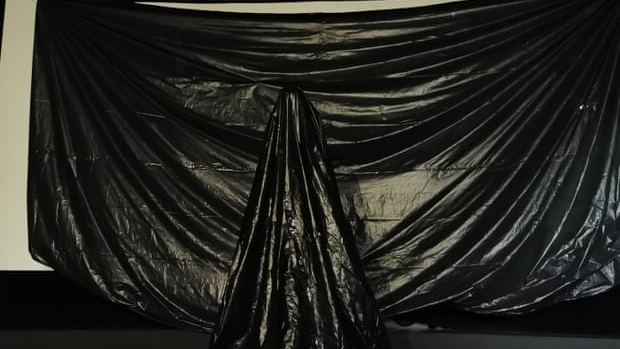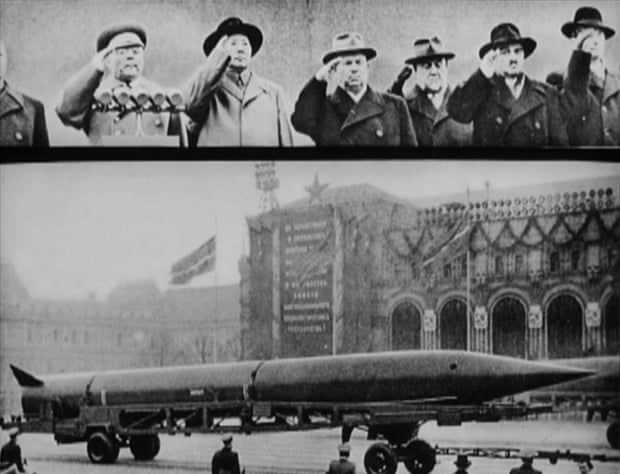Nuclear nightmares: the Belarus film festival taking a stand against repression
Mark Cousins, The Guardian
4 January 2020, 23:25
 In a country where history casts a long shadow and authoritarianism reigns, a guerrilla festival team commandeer cinemas to champion liberty – if the KGB don’t get there first
In a country where history casts a long shadow and authoritarianism reigns, a guerrilla festival team commandeer cinemas to champion liberty – if the KGB don’t get there first
It’s the opening night of a film festival in Belarus, the forest country on the fault line between Europe and Russia that was devastated in the 20th century. Such evenings usually involve red carpets and movie stars, but this one features a black veil covering a big screen, like a mirror at an Irish wake.
In front of the shrouded screen is an eight-metre pyramid, also covered in black plastic. Music starts. People crawl in slow motion from behind and below the movie screen. They’re dressed in 1940s clothes. Some look homeless, or like shtetl Jews. Minsk was almost 50% Jewish until the Nazis arrived. The slo-mo people uncover the pyramid to reveal a man on stilts, like a Louise Bourgeois spider, who terrorises them. When he finishes, a man walks on stage and says he’s a campaigner against capital punishment in Belarus.
It’s a visual shock, something I’ve never seen before. Anti-glamour and morally serious, an electrifying start to a film festival. It makes me think of why I’m here. Thanks to the Russian company Atomstroyexport, Belarus is getting new nuclear reactors, so Watch Docs’ festival director, Tanya Hatsura-Yavorska, asked if they could show my film Atomic: Living in Dread and Promise, a collaboration with the band Mogwai. I loved the idea: the film has been shown near Chernobyl, in Coventry cathedral and in Hiroshima. As Belarus suffered more from the Chernobyl disaster than any country, it would be an honour.
Watch Docs planned to show the film in conventional cinemas but, as they’re state owned, the Belarus KGB prevented the screening. Plan B – to show it somewhere atmospheric, like a disused bunker – was also stopped. As I watch the dance macabre on opening night, I still don’t know if Atomic will screen at all. Last night in my bedsit in Minsk, I woke up shouting. In my nightmare, men had broken in, like they arrive in Josef K’s bedroom in Kafka’s The Trial. I had nuclear nightmares in the 80s, but they stopped at the end of the cold war.
On opening night, after the anti-capital punishment person, Hatsura-Yavorska speaks. She says Watch Docs is about the limits of freedom and un-freedom. Belarus has had the same president Alexander Lukashenko, since 1994. Authoritarian and dissent-averse, his country has vestiges of Soviet double-speak. She finishes, and the opening film begins. It’s The Trial, a documentary about the imprisonment of Russian-Ukrainian film-maker Oleg Sentsov. In it Sentsov – who has since been released – mocks the Russian legal system and laughs when his sentence is extended. It’s a film about being scared but not afraid, like Hatsura-Yavorska and her team – almost all women – are scared but not afraid. The confidence to cover the screen in black, to ask such serious questions about liberty and cinema. Compared with this, most film festivals look meagre and transient.
Days pass. In Minsk’s massive museum of the second world war, I see clips from Elem Klimov’s shattering Belarusian war movie Come and See (recently restored and soon to be rereleased). Nazis herd villagers into a barn and then burn it. The clips are uncredited; the museum plays them as if they’re documentary footage.
We drive to Khatyn, where there is a memorial to the destroyed villages depicted by Klimov. Bells toll throughout the forest where the village once was. There’s a huge statue of the only adult to survive the atrocity – a man carrying his dead son. Altogether, 628 villages were eradicated by the Nazis. Up to a quarter of the country’s 9 million people are thought to have died. The lowest estimates are 1.5 million. I stand in this December forest, listening to bells that have rung for 50 years, trying to comprehend this. I fail.
![Nuclear nightmares: the Belarus film festival taking a stand against repression]()
A day later, I hear that Atomic will be screened – in OK16, a huge railway workshop turned arts venue in the south of Minsk. Ten minutes before it starts, I still don’t know exactly where I’m going. But then I’m in an auditorium with beautiful projection and sound, and there’s a big audience – the power of Facebook – and Tanya is introducing. She says the festival “wanted to show this film somewhere more auspicious, but the three-letter organisation would not let that happen”.
We watch Atomic. In its opening scene, a British government official in an old information film says to camera: “The government has decided that, in the present state of international tension, you should be told how to protect yourselves from the dangerous effects of nuclear attack.” It chimes with this place, and with this festival: being told what to do, the fear of thermonuclear disaster.
Watch Docs uses films to express fear and push against it. I was scared in Minsk on that first night. After that, I was reminded why movies matter. Though protestors in Belarus risk imprisonment, they’re less scared than the three-letter organisation that tries to corral them. The KGB is afraid of their clarity of thought, seriousness and imagination.
4 January 2020, 23:25

‘Anti-glamour’ … the big screen on opening night.
It’s the opening night of a film festival in Belarus, the forest country on the fault line between Europe and Russia that was devastated in the 20th century. Such evenings usually involve red carpets and movie stars, but this one features a black veil covering a big screen, like a mirror at an Irish wake.
In front of the shrouded screen is an eight-metre pyramid, also covered in black plastic. Music starts. People crawl in slow motion from behind and below the movie screen. They’re dressed in 1940s clothes. Some look homeless, or like shtetl Jews. Minsk was almost 50% Jewish until the Nazis arrived. The slo-mo people uncover the pyramid to reveal a man on stilts, like a Louise Bourgeois spider, who terrorises them. When he finishes, a man walks on stage and says he’s a campaigner against capital punishment in Belarus.
It’s a visual shock, something I’ve never seen before. Anti-glamour and morally serious, an electrifying start to a film festival. It makes me think of why I’m here. Thanks to the Russian company Atomstroyexport, Belarus is getting new nuclear reactors, so Watch Docs’ festival director, Tanya Hatsura-Yavorska, asked if they could show my film Atomic: Living in Dread and Promise, a collaboration with the band Mogwai. I loved the idea: the film has been shown near Chernobyl, in Coventry cathedral and in Hiroshima. As Belarus suffered more from the Chernobyl disaster than any country, it would be an honour.
Watch a trailer for Atomic
Watch Docs planned to show the film in conventional cinemas but, as they’re state owned, the Belarus KGB prevented the screening. Plan B – to show it somewhere atmospheric, like a disused bunker – was also stopped. As I watch the dance macabre on opening night, I still don’t know if Atomic will screen at all. Last night in my bedsit in Minsk, I woke up shouting. In my nightmare, men had broken in, like they arrive in Josef K’s bedroom in Kafka’s The Trial. I had nuclear nightmares in the 80s, but they stopped at the end of the cold war.
On opening night, after the anti-capital punishment person, Hatsura-Yavorska speaks. She says Watch Docs is about the limits of freedom and un-freedom. Belarus has had the same president Alexander Lukashenko, since 1994. Authoritarian and dissent-averse, his country has vestiges of Soviet double-speak. She finishes, and the opening film begins. It’s The Trial, a documentary about the imprisonment of Russian-Ukrainian film-maker Oleg Sentsov. In it Sentsov – who has since been released – mocks the Russian legal system and laughs when his sentence is extended. It’s a film about being scared but not afraid, like Hatsura-Yavorska and her team – almost all women – are scared but not afraid. The confidence to cover the screen in black, to ask such serious questions about liberty and cinema. Compared with this, most film festivals look meagre and transient.
Days pass. In Minsk’s massive museum of the second world war, I see clips from Elem Klimov’s shattering Belarusian war movie Come and See (recently restored and soon to be rereleased). Nazis herd villagers into a barn and then burn it. The clips are uncredited; the museum plays them as if they’re documentary footage.
We drive to Khatyn, where there is a memorial to the destroyed villages depicted by Klimov. Bells toll throughout the forest where the village once was. There’s a huge statue of the only adult to survive the atrocity – a man carrying his dead son. Altogether, 628 villages were eradicated by the Nazis. Up to a quarter of the country’s 9 million people are thought to have died. The lowest estimates are 1.5 million. I stand in this December forest, listening to bells that have rung for 50 years, trying to comprehend this. I fail.

Auspicious … a scene from Atomic: Living in Dread and Promise
A day later, I hear that Atomic will be screened – in OK16, a huge railway workshop turned arts venue in the south of Minsk. Ten minutes before it starts, I still don’t know exactly where I’m going. But then I’m in an auditorium with beautiful projection and sound, and there’s a big audience – the power of Facebook – and Tanya is introducing. She says the festival “wanted to show this film somewhere more auspicious, but the three-letter organisation would not let that happen”.
We watch Atomic. In its opening scene, a British government official in an old information film says to camera: “The government has decided that, in the present state of international tension, you should be told how to protect yourselves from the dangerous effects of nuclear attack.” It chimes with this place, and with this festival: being told what to do, the fear of thermonuclear disaster.
Watch Docs uses films to express fear and push against it. I was scared in Minsk on that first night. After that, I was reminded why movies matter. Though protestors in Belarus risk imprisonment, they’re less scared than the three-letter organisation that tries to corral them. The KGB is afraid of their clarity of thought, seriousness and imagination.

